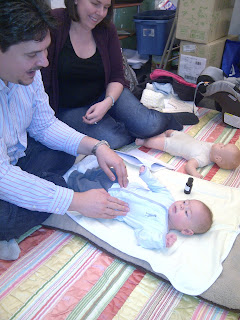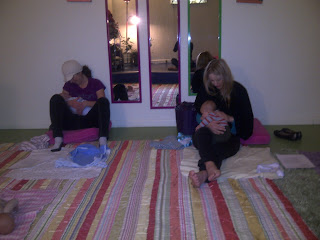Ashley Montaqu in his book Touching: The Human Significance of the Skin, stated "If our culture we could learn and understand the importance of fathers as well as mothers giving their infants adequate tactile satisfactions, we would be taking a considerable step toward the improvement of human relations."
Infant Massage is a wonderful way for Fathers and Partners to bond with baby. Mom often has breastfeeding which is her one on one personal interaction with baby. Fathers and Partners often feel left out or not as involved with their child beyond diaper changing. Massage provides the one on one time, eye contact and calming touch that helps to build attachment and a lifelong bond of parent and child.
Dec. 23, 2012
Calendar
Saturday, December 22, 2012
Tuesday, December 18, 2012
Friday, December 14, 2012
Monday, December 10, 2012
Infant Massage Testimonial December 2012
"Massage is going wonderfully! Matt has been giving Oliver a massage every night before bed and he loves it. I've been giving our 3 year old daughter, Grace, a massage every night too (face and lower arms per her request) and she loves it too. So we're using it daily and really enjoying it. Thank you so much!"
Heather
Mom of 10 week old Oliver and 3 year old Grace
Private Infant Massage Class in Denver
December 2012
Heather
Mom of 10 week old Oliver and 3 year old Grace
Private Infant Massage Class in Denver
December 2012
Sunday, December 9, 2012
Infant Massage and Preterm Infants
"Most of the data on the positive effects of infant massage comes from the studies on preterm infants. Most of these investigators reported greater weight gain and better performance on developmental tasks for the preterm infants receiving massage therapy.
Interestingly, those who did not report significant weight gain among massaged infants used a light stroking procedure, which we have since found is aversive to babies, probably because it is experienced as a tickle stimulus.
One of the studies used in this meta-analysis was conducted in our lab starting in 1984. The massage sessions were comprised of 3 five-minute phases. During the first and third phases, tactile stimulation was given. The newborn was placed in a prone position and given moderate pressure stroking of the head and face region, neck and shoulders, back, legs and arms for five one-minute segments. The Swedish-like massage was given because, as already noted, infants preferred some degree of pressure, probably because the light stroking was experienced as a tickle stimulus.
The results of this study (published in Pediatric in 1986) suggested that:
1. The massaged infants gained 47 percent more weight, even though the groups did not differ in calorie intake;
2. The massaged infants were awake and active a greater percentage of the observation time (much to our surprise, since we had expected that the massage would stimulate a soporific state and greater sleep time, leading to weight gain via lesser energy expenditure and calories);
3. The massaged infants showed better performance on the Brazelton Scale on habituation, orientation, motor activity and regulation of state behavior;
4. The massaged infants were hospitalized, on average, six fewer days than the control infants, yielding a savings in hospital costs of approximately $3,000 per infant."
Tiffany Field, Ph.D.
Touch Research Institute
University of Miami School of Medicine
Edited from the Zero to Three Journal, October/November 1993
Interestingly, those who did not report significant weight gain among massaged infants used a light stroking procedure, which we have since found is aversive to babies, probably because it is experienced as a tickle stimulus.
One of the studies used in this meta-analysis was conducted in our lab starting in 1984. The massage sessions were comprised of 3 five-minute phases. During the first and third phases, tactile stimulation was given. The newborn was placed in a prone position and given moderate pressure stroking of the head and face region, neck and shoulders, back, legs and arms for five one-minute segments. The Swedish-like massage was given because, as already noted, infants preferred some degree of pressure, probably because the light stroking was experienced as a tickle stimulus.
The results of this study (published in Pediatric in 1986) suggested that:
1. The massaged infants gained 47 percent more weight, even though the groups did not differ in calorie intake;
2. The massaged infants were awake and active a greater percentage of the observation time (much to our surprise, since we had expected that the massage would stimulate a soporific state and greater sleep time, leading to weight gain via lesser energy expenditure and calories);
3. The massaged infants showed better performance on the Brazelton Scale on habituation, orientation, motor activity and regulation of state behavior;
4. The massaged infants were hospitalized, on average, six fewer days than the control infants, yielding a savings in hospital costs of approximately $3,000 per infant."
Tiffany Field, Ph.D.
Touch Research Institute
University of Miami School of Medicine
Edited from the Zero to Three Journal, October/November 1993
Subscribe to:
Comments (Atom)















